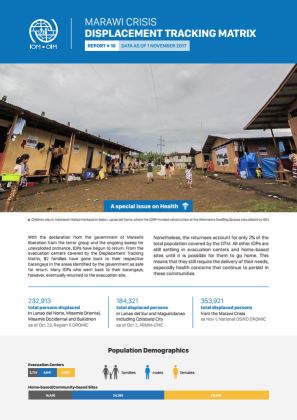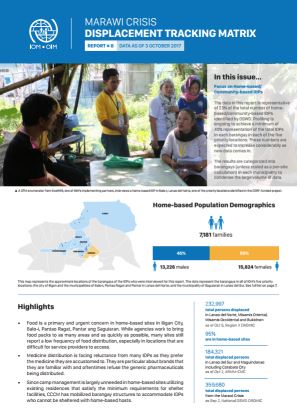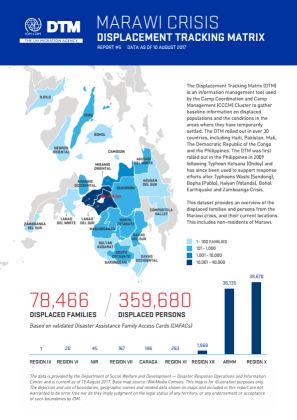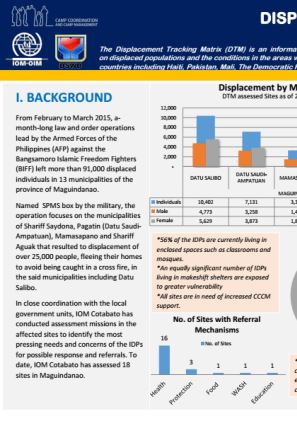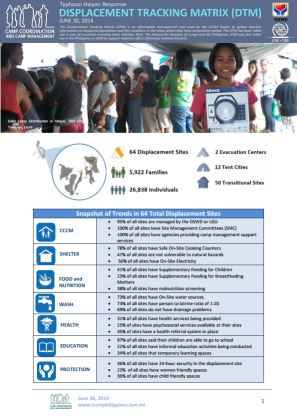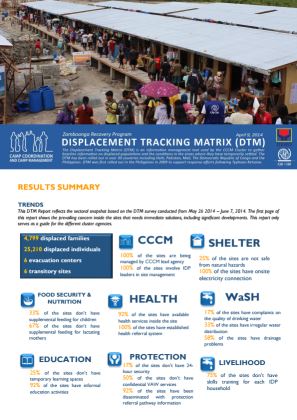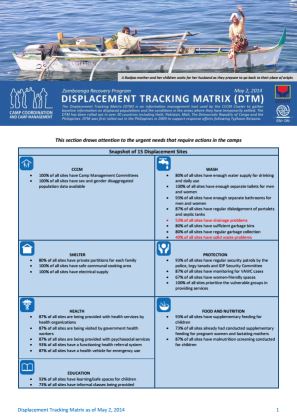-
Countries
-
Data and Analysis
-
Special Focus
-
Crisis Responses
Philippines
Philippines
IDPs tracked
Displacement Movements
113,000
IDMC 2023
Data collection round
About Philippines
The Displacement Tracking Matrix (DTM) was first rolled out in the Philippines in 2009 following Typhoon Ketsana (Ondoy) and has since been used to support response efforts to major emergencies in the country including Typhoons Washi (Sendong), Bopha (Pablo), Haiyan (Yolanda), Bohol Earthquake and the Zamboanga and Marawi Crises. IOM Philippines has been promoting the adoption of the system by government partners both at national and local levels.
The Philippines’ Department of Social Welfare and Development (DSWD) has agreed to use the DTM site assessment tool to monitor the needs of the displaced populations in evacuation centres and other displacement settings. In addition, the DSWD has piloted the DTM Biometric Registration and Verification (BRaVe) system as a preparedness measure to register vulnerable families in hazard-prone communities and is considering using the system for its other programmes.
Contact
Francis BORJA
Information Management Officer
FBorja@iom.int
Current Donors
- ECHO
Philippines — Marawi Crisis Report 11 (15 November 2017)
The declaration of Marawi’s liberation from armed groups that took control of the city, has opened it back to residents. Beginning last 29 October 2017, residents from periphery barangays have begun to return, starting with nine barangays cleared by the military for unexploded ordnance.
Philippines — Marawi Crisis Report 10: Special Issue — Health (1 November 2017)
On 23 May 2017, a group of rebel fighters called the “Maute Group” attacked the city of Marawi in Lanao del Sur, population: 211,000+. The assault has displaced hundreds of people.
Philippines — Marawi Crisis Report 9: Special Issue — Food (25 October 2017)
On 23 May 2017, a group of rebel fighters called the “Maute Group” attacked the city of Marawi in Lanao del Sur, population: 211,000+. The assault has displaced hundreds of people.
Philippines — Marawi Crisis Report 8 (3 October 2017)
On 23 May 2017, a group of rebel fighters called the “Maute Group” attacked the city of Marawi in Lanao del Sur, population: 211,000+. The assault affected 98% of the population, displacing 359,680 people.
Philippines — Marawi Crisis Report 7 (28 September 2017)
On 23 May 2017, a group of rebel fighters called the “Maute Group” attacked the city of Marawi in Lanao del Sur, population: 211,000+. The assault affected 98% of the population, displacing 359,680 people.
Philippines — Marawi Crisis Report 6 (30 August 2017)
On 23 May 2017, a group of rebel fighters called the “Maute Group” attacked the city of Marawi in Lanao del Sur, population: 211,000+. The assault affected 98% of the population, displacing 359,680 people.
Philippines — Marawi Crisis Report 5 (10 August 2017)
The Displacement Tracking Matrix (DTM) is an information management tool used by the Camp Coordination and Camp Management (CCCM) Cluster to gather baseline information on displaced populations and the conditions in the areas where they have temporarily settled.
Philippines — Marawi Crisis Report 4 (31 July 2017)
The Displacement Tracking Matrix (DTM) is an information management tool used by the Camp Coordination and Camp Management (CCCM) Cluster to gather baseline information on displaced populations and the conditions in the areas where they have temporarily settled.
Philippines — Marawi Crisis Report 3 (3 July 2017)
During the reporting period DTM identified 3,798 displaced families (16,070 individuals).
Philippines — Marawi Crisis Report 2 (25 June 2017)
During the reporting period DTM identified 3,463 displaced families (15,994 individuals).
Philippines — Marawi Crisis Report 1 (16 June 2017)
During the reporting period DTM identified 820 displaced families (3,929 individuals). 5 evacuation centers were surveyed and issues in the following areas were observed: site management, shelter, WASH, education and protection.
Philippines – Children of Peace Project (10 November 2016)
Children comprise more than half of all the recorded internally displaced persons (IDPs). DTM assessed 31 communities and recorded a total of 5,388 conflict affected families (28,559 individuals).
Philippines — Displacement Snapshot Surigao Del Sur (17 September 2015)
In close coordination with the local government units and the DSWD, IOM Cotabato conducted an assessment mission on 17 September in Tandag City Sports Center where 2,886 IDPs remain displaced.
Philippines — Displacement Snapshot Surigao del Sur and Davao City (23 October 2015)
About 90% of the IDPs belong to the Manobo ethnic group. This necessitates culturally appropriate interventions that respect the IP’s identity and culture. Tandag site has the most number of persons with special vulnerabilities.
Philippines — Displacement Snapshot UCCP Hara, Evacuation Center, Davao City (1 October 2015)
In the UNHCR’s latest assessment in Talaingod and Kapalong, the IDPs revealed a legitimate fear not to return to their communities due to insecurity and presence of armed troops.
Philippines — Displacement Snapshot Maguindanao (22 May 2015)
From February to March 2015, a-month-long law and order operations lead by the Armed Forces of the Philippines (AFP) against the Bangsamoro Islamic Freedom Fighters (BIFF) left more than 91,000 displaced individuals in 13 municipalities of the province of Maguindanao.
Philippines — Displacement Snapshot Maguindanao (24 April 2015)
From February to March 2015, a-month-long law and order operations lead by the Armed Forces of the Philippines (AFP) against the Bangsamoro Islamic Freedom Fighters (BIFF) left more than 91,000 displaced individuals in 13 municipalities of the province of Maguindanao. To date, I
Philippines — Mayon Volcano Report (7 October 2014)
A total of 41 evacuation centers were surveyed for this assessment in the five municipalities and two cities affected. There are a total of 11,096 families with 42,897 individuals.
Philippines — Typhoon Haiyan Displacement Report (30 June 2014)
Typhoon Haiyan hit the Philippines on 8 November 2013. It was one of the most powerful typhoons to ever make landfall.
Philippines — Zamboanga Recovery Programme Report (9 June 2014)
This DTM Report reflects the sectoral snapshot based on the DTM survey conducted from 26 May 2014 – 7 June 2014. The first page of this report shows the prevailing concern inside the sites that needs immediate solutions, including significant developments.
Philippines — Typhoon Haiyan Displacement Report (May 2014)
According to the Government of the Philippine’s Disaster Response Operations Monitoring and Information Center (DROMIC), some 4 million people were internally displaced from their homes due to the Typhoon Haiyan (local name Yolanda) disaster- over a quarter of the entire affected population of 14
Philippines — Zamboanga Recovery Programme Report (2 May 2014)
On 9 September 2013 a group of Moro National Liberation Front (MNLF) attacked Zamboanga City in Western Mindanao, Philippines. An estimated 118,000 individuals were affected by the armed conflict. Displaced families were scattered to 63 evacuation sites set-up around the city.
Philippines — Typhoon Haiyan Displacement Report (14 April 2014)
Typhoon Haiyan hit the Philippines on 8 November 2013. It was one of the most powerful typhoons to ever make landfall.
Philippines — Zamboanga Recovery Programme Report (8 April 2014)
This DTM Report reflects the sectoral snapshot based on the DTM as of 3 1March 2014. There are already 4,999 displaced families with 26,477 individuals in existing 6 evacuation centers and 5 transitory sites. Lunzuran Barangay Hall, Divisoria National High School and Sta.



